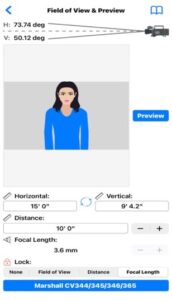
How to Choose the Correct Lens for Your Next AV Project
Choosing the right lens can seem complicated when designing for a desired camera position, shot, or perspective. Zoom cameras take out some of the guesswork, however even these cameras have a minimum and a maximum focal range. Then add in differences between parfocal and varifocal zoom lenses, further complicates the mission and might not be relevant to project scope.
 In generally terms; Focal Length (mm) describes distance between rear lens elements and sensor in digital cameras. Depending on size of sensor a given Focal Length (mm) lens will capture a specific angle-of-view (AOV) in degrees. The higher the numerical Focal Length in mm the longer or more-narrow the shot becomes, these longer focal length lenses are considered telephoto, given same sensor size. Likewise, the lower the Focal Length in mm, same sensor size, the wider the shot becomes capturing a wider AOV perspective of the scene.
In generally terms; Focal Length (mm) describes distance between rear lens elements and sensor in digital cameras. Depending on size of sensor a given Focal Length (mm) lens will capture a specific angle-of-view (AOV) in degrees. The higher the numerical Focal Length in mm the longer or more-narrow the shot becomes, these longer focal length lenses are considered telephoto, given same sensor size. Likewise, the lower the Focal Length in mm, same sensor size, the wider the shot becomes capturing a wider AOV perspective of the scene.
 Not to complicate further but given same fixed Focal Length; a larger sensor size will widen the AOV and smaller sensor size the more narrow. This creates a challenge to match say a DSLR focal length look with a corresponding AOV in a miniature or smaller camera sensor. For instance, a 35mm lens on a DSLR camera is a relatively wide AOV perspective, however on a 1/3” or 1/2” sensor it is more of a telephoto or narrow AOV perspective.
Not to complicate further but given same fixed Focal Length; a larger sensor size will widen the AOV and smaller sensor size the more narrow. This creates a challenge to match say a DSLR focal length look with a corresponding AOV in a miniature or smaller camera sensor. For instance, a 35mm lens on a DSLR camera is a relatively wide AOV perspective, however on a 1/3” or 1/2” sensor it is more of a telephoto or narrow AOV perspective.
Field-of-View (FOV) and Angle-of-View (AOV) vary slightly because FOV considers entire field including Depth-of-Field (DOF) or minimum distance from camera lens in-focus to farthest distance in-focus where nearer or farther are out-of-focus. AOV is an angle from glass extending outward as an angle in degrees (ie. 85°, 100°) essentially different angles from glass to infinity extending outward.
 Fixed Prime vs Varifocal lenses offer different perspectives even if the Focal Length in the Varifocal (variable focal length) lens is set to match the Fixed Focal Length Prime lens. When a Varifocal lens is used, different settings within the variable focal range effect Depth-of-Field (DOF). Fixed Prime lenses will hold everything within the FOV in focus or might be stated as “near contact to infinity in focus”.
Fixed Prime vs Varifocal lenses offer different perspectives even if the Focal Length in the Varifocal (variable focal length) lens is set to match the Fixed Focal Length Prime lens. When a Varifocal lens is used, different settings within the variable focal range effect Depth-of-Field (DOF). Fixed Prime lenses will hold everything within the FOV in focus or might be stated as “near contact to infinity in focus”.
 To be able to choose the right Focal Length lens for a specific camera model with corresponding sensor size two measurements will need to be taken; distance to target scene (or shot) and width of scene (or shot) to be captured by camera at that distance. Then plugging these data points into a FOV calculator or app will provide a Focal Length on given sensor size. For instance, a 1/3” camera sensor at a 10 foot distance needing to capture a 15’ horizontal shot (16:9 HD ratio) would require a 3.6mm focal length (image from pCAM Pro app from iPhone shown here).
To be able to choose the right Focal Length lens for a specific camera model with corresponding sensor size two measurements will need to be taken; distance to target scene (or shot) and width of scene (or shot) to be captured by camera at that distance. Then plugging these data points into a FOV calculator or app will provide a Focal Length on given sensor size. For instance, a 1/3” camera sensor at a 10 foot distance needing to capture a 15’ horizontal shot (16:9 HD ratio) would require a 3.6mm focal length (image from pCAM Pro app from iPhone shown here).
Then it’s as easy as matching that Focal Length (mm) to an appropriate lens model as a Fixed Prime lens or Varifocal lens that falls within the range. For example, a 2.8~12mm will cover the 3.6mm requirement with lots of flexibility to adjust.
Check out some of our other blogs about Marshall cameras and monitors:
Marshall POV Cams Make Their Way Into the eSports Live Stream Arena
Marshall POV Cam Gets Inside Shot of Georgia Dome Implosion
Southeast Missouri State Sharpens Its Television & Film Productions Using Marshall Monitors